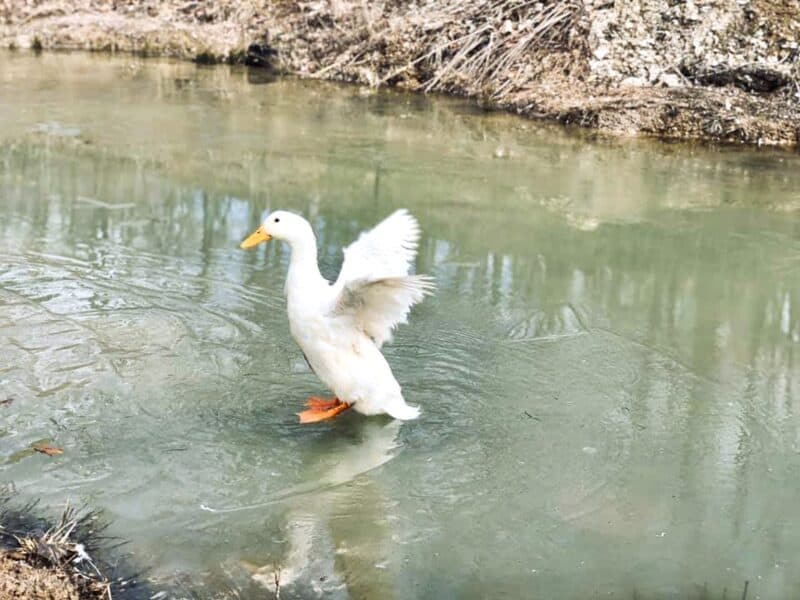The one question I hear over and over again from prospective duck keepers is how they can keep their birds from flying away.

It makes sense, of course: we watch ducks fly all over the place out in nature. But it’s different for domestic ducks, as most of them cannot fly. Most, but not all!
For the breeds that can, you really do have to have a plan for keeping them in place or else they will eventually fly away. How about Pekins – Can they fly?
No, Pekin ducks cannot fly. As a rule, they are too large and heavy, and their wing muscles are too underdeveloped to support flight, though they might make some flapping leaps occasionally to get up or down.
Pekins are the most popular domestic duck in the United States, and if you want to start your journey with them, or just expand your flock with the breed, you won’t have to worry about keeping them contained. Even a modestly tall fence is enough to hold them back.
Keep reading, and I’ll tell you more about the flight capabilities of Pekins, or should I say the lack thereof!
Pekins Are Typically Heavy
As mentioned, Pekins are simply much too heavy to fly, at any age. When fully mature, males can weigh 10 pounds or a little more, and females are right behind them at around 9 pounds. These are hefty ducks, for sure!
More than that, they tend to be stocky with an almost rectangular body, and seasoned keepers can tell at a glance just by looking at them that they are unable to fly.
And, before you ask, they can’t fly even when they are younger or a little underweight for reasons that we will discover.
They Have a Small Wing-to-Body Ratio, Too
Another physiological factor that keeps Pekins ground-bound is their small wing-to-body ratio. It might not look like it when they have their wings folded seamlessly along the sides of their body, but these big birds have surprisingly small wings.
Smaller wings mean less lift, and that’s the last thing you can deal with when you are already a big bird!
The simple fact of the matter is that their wings just don’t enable them to truly get off the ground for proper flight – although they’re enough to break their fall or give them just a little bit of a boost when jumping.
What About Wild Pekins? Can They Fly?
Pekins are domestic ducks, not wild ducks, and have been with us for over 100 years. Way back then, and during that entire time, Pekins have continually been selected for fast growth, great weight, and a high carcass yield.
They were also continually selected for their lack of ability to fly. Obviously, no duck keeper wants their money makers to take off on migration or look for greener pastures!
That said, there are so many Pekins around the world that there are wild populations, although they are more properly called feral.
Even though these ducks are living out in the wild, and you might even spot them at the lake living among other genuinely wild species, they are still unable to fly.
They might not be classified as a truly flightless bird like a penguin or ostrich, but for all practical purposes, Pekins are still flightless in every way that matters, even if they are living out in the wild.
Pekins Might Be Able to Make Flapping Leaps, but This Is Not True Flight
Every once in a while, you’ll see someone online swearing up and down that their particular Pekin, or flock of Pekins, is able to fly. Typically, this person is highly argumentative, unable to provide evidence, and somehow unwilling to elaborate on their claim.
Now, I’m not calling these people liars, but I am saying that if they are telling the truth, what they have is a truly exceptional Pekin or they are calling a flapping leap or some running and fluttering along the ground flight- and it isn’t.
Pekins, like all other ducks and indeed all domestic poultry, will use their wings instinctively. They do this if they have to jump down from a high place or are knocked off, when they are startled, or if they have an urge to fly.
They will of course also use their wings to aid them when trying to jump up and over an obstacle or to reach a higher vantage point.
Their wings can benefit them in all of these circumstances, but being able to jump up 3 feet or so while flapping madly does not constitute flight in any way. Don’t get fooled by hyperbole!
Tom has lived and worked on farms and homesteads from the Carolinas to Kentucky and beyond. He is passionate about helping people prepare for tough times by embracing lifestyles of self-sufficiency.
